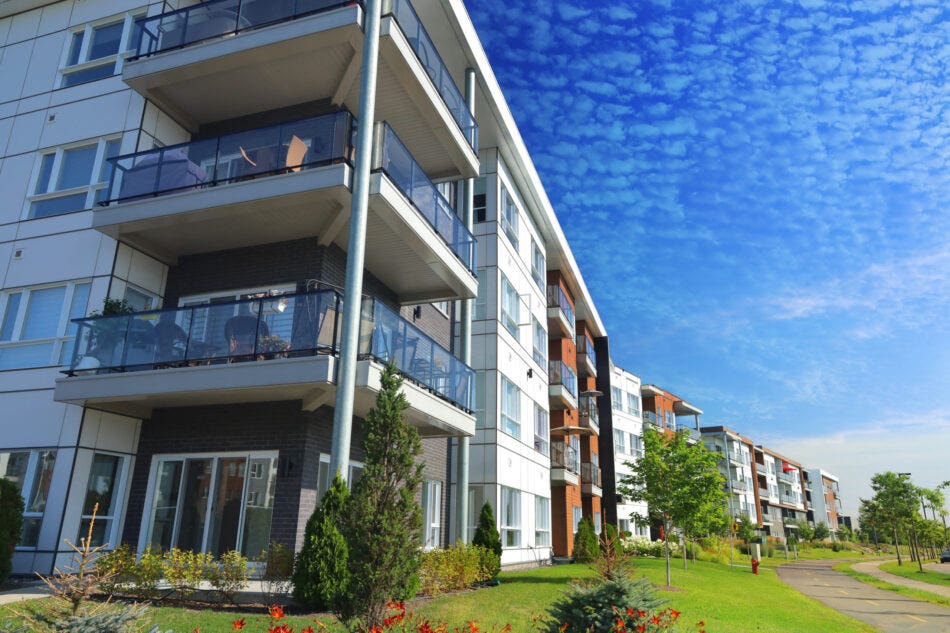Condo corporations have an important role to play in reversing skyrocketing condo insurance premiums and deductibles in Canada.
Purchasing insurance for a condominium/strata corporation in the past 24 months has been nothing short of a nightmare—for corporations and brokers alike.
Insurers have been tightening their capacity and significantly increasing premiums and deductibles in response to surges in catastrophic weather events, water damage claims, rising construction costs and more.
Some reports note renewal premiums for Canadian condo corporations increased, on average, by 40 per cent in 2020. Deductibles have also spiked since 2019, making insurance the largest single expense for most condo corporations (or strata corporations as they’re known in B.C.). This expense is then passed on to owners through monthly condo fees.
While we have recently seen a glimmer of hope that insurance companies are softening massive rates in premiums and deductibles, the question remains: How can we correct the condo insurance crisis?
To answer this question, we must first understand how we arrived here. Let’s explore.
Hit Hard by Extreme Weather
Simply put, insurance is the law of large numbers. The premiums of the many pay for the losses of the few. Unfortunately, insurance companies have been hit hard over the past decade and have paid out far more in claims than they have collected in premiums.
One of the biggest factors impacting insurance rates is severe weather. According to the Insurance Bureau of Canada (IBC), seven of the top 10 most expensive natural disasters in Canadian history occurred in the past 10 years.
The frequency of catastrophic losses (meaning the damage is more than $25 million) has been rapidly increasing across the country. According to the IBC there were:
- 47 catastrophes between 2001 and 2010, of which 25 were water related.
- 102 catastrophes between 2011 and 2020, of which 36 were water related.
As the number of catastrophic events have spiked, so has the price of insured damage. In 2020 alone, there was $2.4 billion in insured damage, compared to the annual average of $425 million between the years of 1983 and 2008.
After years of losing money, insurers have been forced to take drastic measures, including:
- increasing rates;
- increasing deductibles;
- removing or decreasing some coverages; and,
- being tougher on underwriting requirements.
Are Condos too Risky?
Condo housing (which includes multi-storey buildings, townhomes and duplexes) presents unique risks for insurers, which also affects coverage, rates and availability.
One hazard is that multi-storey buildings are more susceptible to water damage, be it from overflowing appliances or burst pipes that can quickly damage several units.
Maintenance is another concern. In condos, maintenance depends on the collective efforts of many people—some of whom may disregard standard upkeep or respond slowly to issues, such as leaking appliances. Poor maintenance can result in a greater number of claims, which in turn leads to higher premiums.
These unique risks, coupled with extreme weather, has resulted in many insurers simply opting to exit the condo insurance market. This has put big pressure on the insurers who continue to provide this coverage, resulting in:
- reduced capacity (meaning insurers are willing to provide less coverage);
- re-insurers reducing their risk tolerance and increasing costs; and,
- significantly tighter underwriting guidelines that weed out properties that pose a higher risk (based on factors such as age, maintenance schedules, location, changes made to the building and more).
Correcting the Condo Insurance Crisis
Extreme weather is likely going to continue. And new challenges (such as the drastic increase in construction material costs, which is impacting replacement costs) will continue to rise and drive insurance premiums.
All of this to say, we cannot rely on insurers to correct the condo insurance crisis on their own; condo/strata corporations must also be part of the solution.
If corporations can reduce the number of claims in the coming years, this will help insurers return to profitability, and enable them to underwrite condos at a more competitive price.
Here are some actions that condo/strata corporations can take:
Proactively manage your risk
Create, publish and follow a comprehensive maintenance plan to protect your project from suffering a loss. This can include:
- Creating and distributing newsletters to educate owners and tenants on water damage hazards—be it from an improperly maintained toilet, freezing of water lines or DIY plumbing repairs.
- Enlisting the services of your broker to help your condo board understand where they face the greatest exposure, from both a property and liability standpoint.
- Keeping up with the annual maintenance and repairs as outlined in your reserve fund studies.
- Enlisting the services of an inspector to view the property to identify potential issues that need to be resolved.
- Investigating new technology (e.g., leak protection, alarm systems) that demonstrate your proactive approach to risk management.
Don’t use insurance to fund maintenance issues
Be proactive and respond immediately if there are signs of troubles, such as with a roof or heating system. Insurance should only be used for unexpected losses that may occur.
Think twice before submitting a claim
Have your condo board and/or property manager speak with your broker before submitting a claim. Your broker can help you determine the impact this claim could have on future insurability.
All insurance providers follow the same basic principle—they build their coverages and determine their pricing using past events to predict what will happen in the future.
Our only way out of the condo insurance crisis is for condo/strata corporations to take corrective action to reduce their risks and hazards, ultimately reducing claims.

